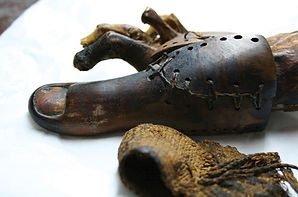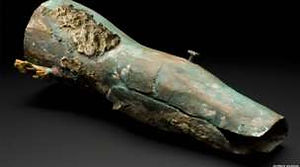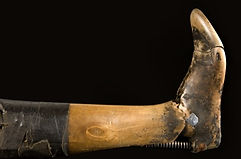
TIMELINE


600 B.C. – The Greville Chester toe, created by the Egyptians was made of cartonnage,a paper maché material made out of linen, glue, and plaster.
300 B.C. – The oldest known prosthetic leg was the Capua leg and it was crafted by Romans from bronze and iron with a wooden core. It was once in the Royal College of Surgeons, but was destroyed during WWII. A replica is now at the Science Museum in London.
1529 - Ambroise Pare introduces amputation to the medical world.
1696 - Pieter Andriannszoon Verduyn created the first non-locking prosthetic for below the knee.
1800 - James Potts designed a lower limb prosthesis which had an articulating foot controlled by catgut tendons from the knee to the ankle. It was constructed of a wooden shank and socket, a steel knee joint in addition to the articulating knee. It became known as the "Anglesey leg".
1843 - Sir James Syme introduced his method of amputating at the ankle, which allowed the patient to walk again. Amputations were made at the thigh before this.
1846 - Dr. Benjamin F. Palmer, improved the “Anglesey Leg” with the addition of an anterior spring, smooth appearance and concealed tendons
1856 - Anglesey leg became know as the American leg, when A.A. Marks gave knew, ankle and toe movements articulation control
1858 - Dr. Douglas Bly made his own anatomical leg and it had an articulated ankle with a polished ivory ball in a socket of vulcanized rubber, and allowed inversion and eversion. It became known as the American leg
1918 - Dr. Martin introduced the Belgian Leg which emphasized the anatomy and physiology of the leg and was a large improvement over the American Leg.
1945 – Following World War II, prosthetics were made of wood and leather. They were heavy, and leather can be difficult to keep clean, because it absorbs perspiration.
1970s–1990s – Plastics, polycarbonates, resins, carbon fiber,and laminates were introduced as light, easy-to-clean alternatives. . Synthetic sockets were custom fitted for each patient to provide an individualized, comfortable, and hygienic fit.
2012 - Motor-powered prosthetics are the newest type of prosthetics. They have a small A.I. that allows patients to walk almost as well as non-amputees. They help with balance and movement, and allow patients to walk up and down stairs without straining non-prosthetic parts of their bodies.



